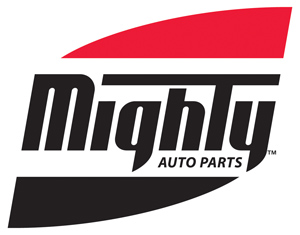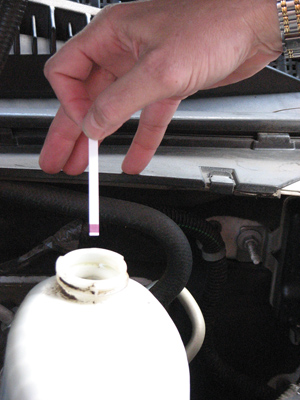 By Keith Healy
By Keith Healy
Director of Undercar Programs
Mighty Auto Parts
As demanding as a driver is of his brakes, a brake system requires even more from the brake fluid. Stepping on the brake pedal, the brake master cylinder transforms mechanical force into hydraulic pressure. Being non-compressible, brake fluid is responsible for transferring hydraulic pressure through brake lines and hoses down to the brake caliper and wheel cylinder assemblies. In addition to the important role of transferring pressure, brake fluid also includes other vital characteristics that play a key role in the performance of the braking system. For the sake of this article, lets look at those characteristics specific to a more common brake fluid in use today, DOT 3.
Having a glycol ether base, DOT 3 brake fluid is hygroscopic, meaning it is capable of absorbing moisture from the atmosphere. Moisture enters the system through minute holes, or pores, in the rubber brake seals, as well as when the master cylinder cap is removed. Research has confirmed that, on average, 2% moisture is absorbed by brake fluid on an annual basis. It is necessary to recognize that the Department of Transportation (DOT) has placed a minimum performance specification for boiling points on all brake fluids. For “dry” fluid (containing no water) the minimum is 401°F and for “wet” fluid (water saturated) the minimum boiling point is 284°F. Now consider what happens to brake fluid after use over a period of time. At a rate of 2% per year, the boiling point of DOT 3 can drop over 9% the first year, and nearly 20% after two years. This has the potential of lowering the boiling point dangerously close to DOT’s minimum specification. But why the minimum?
Being non-compressible, brake fluid acts as a “solid” link between the master cylinder and brake assemblies. With high braking temperatures and a low boiling point, brake fluid may boil and produce vapor in the system. If this occurs, the solid link is broken, as a vapor will compress. A driver applying the brake in this condition would experience a spongy, unresponsive pedal. A devise for testing moisture content is a refractometer, which works on the principle that light passing through a liquid will bend, or refract, at varying rates depending on what is in it. By placing a small amount of brake fluid in the refractometer, a scale will indicate the condition of the fluid.
Other characteristics of DOT 3 fluid that are important to the overall performance of the brake system are the fluid’s ability to flow freely in the brake system at both high and low temperatures, and its ability to lubricate metal and rubber components. Free flowing is an important characteristic in that brake fluid is able to maintain a constant viscosity. Brake fluid is also responsible for lubricating rubber seals and metal components that are moving in the system. Proper lubrication reduces the amount of wear on those moving components.
 Another important characteristic of DOT 3 fluid is that it is non-corrosive to internal parts. Corrosion inhibitors are used in the make up of brake fluid and aid in the protection of the internal surfaces. Over time, these inhibitors break down and can no longer protect the internal surfaces adequately. Depleted corrosion inhibitors allow brake fluid to attack the system. Worn surfaces produce a degree of copper and other particulates that can collect in ABS solenoids and motor valves causing them to malfunction. Measuring the amount of copper content in the fluid is an excellent way to determine the degree of wear or age of the fluid. The recognized threshold for fluid that has lost its ability to protect the system is 200ppm copper content. Easy-to-use test strips are available to quickly determine the degree of brake fluid wear. (See Figure 1)
Another important characteristic of DOT 3 fluid is that it is non-corrosive to internal parts. Corrosion inhibitors are used in the make up of brake fluid and aid in the protection of the internal surfaces. Over time, these inhibitors break down and can no longer protect the internal surfaces adequately. Depleted corrosion inhibitors allow brake fluid to attack the system. Worn surfaces produce a degree of copper and other particulates that can collect in ABS solenoids and motor valves causing them to malfunction. Measuring the amount of copper content in the fluid is an excellent way to determine the degree of wear or age of the fluid. The recognized threshold for fluid that has lost its ability to protect the system is 200ppm copper content. Easy-to-use test strips are available to quickly determine the degree of brake fluid wear. (See Figure 1)
Understanding all the important roles that brake fluid plays, it is clear why brake fluid inspection and replacement is so critical when performing brake service. Maintaining good fluid reduces internal wear while increasing the over-all performance of the system. In other words, inspection and replacement gives your customer the brake performance they expect!
For information on Mighty Auto Parts, call (800) 829-3900 or visit www.mightyautoparts.com.











